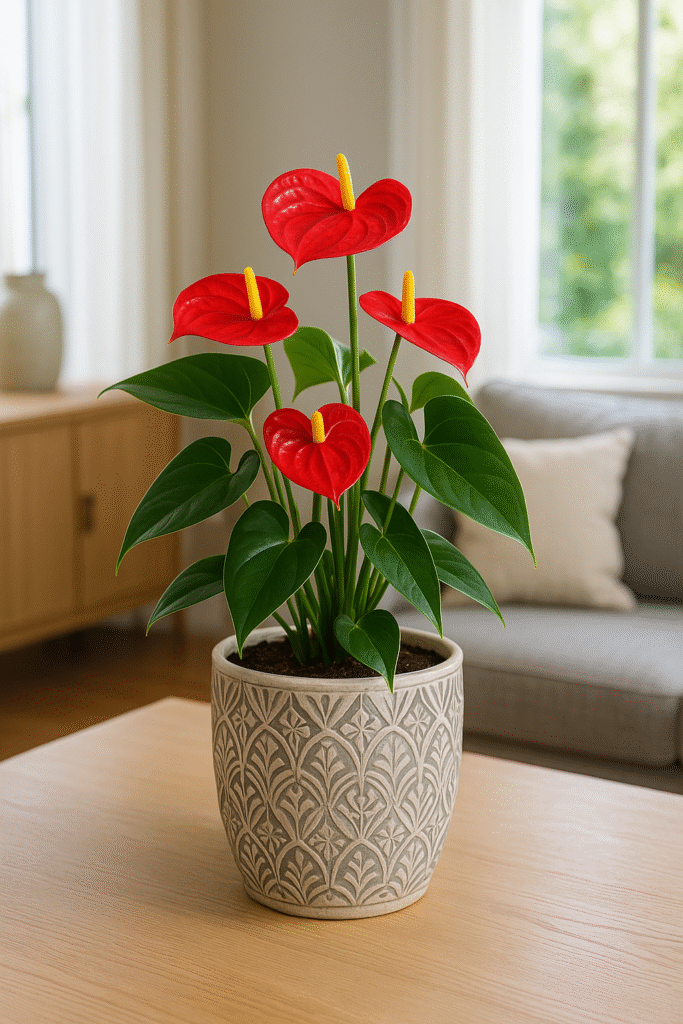The Anthurium (Anthurium andraeanum) is one of the most popular ornamental plants in Brazil and around the world. Known for its shiny green leaves and vibrant, long-lasting flowers, this tropical beauty is a favorite in interior decoration. Native to the rainforests of Central and South America, the anthurium symbolizes exotic beauty, elegance, and is often associated with hospitality and lasting love.
In this article, you’ll learn everything you need to know about this captivating plant: its features, how to care for it, its decorative benefits, and tips to keep it healthy year-round.
Key Characteristics of Anthurium
Anthurium is a perennial tropical plant belonging to the Araceae family. Its most distinctive feature is its inflorescence, composed of a brightly colored spathe (similar to a petal) and a central spadix (a rod-like structure) where the tiny flowers are actually located.
The spathes come in a variety of colors, with red being the most common. However, there are also pink, white, green, purple, and even black varieties. Its glossy heart-shaped leaves add to its ornamental appeal.
In addition to its visual charm, anthurium is a low-maintenance plant that can bloom several times a year, especially in humid environments with indirect light.
How to Care for Anthurium
While relatively easy to grow, anthuriums require specific care to thrive and maintain their vibrant appearance.
1. Light Requirements
Anthuriums prefer bright, indirect light. Direct sunlight can scorch the leaves and flowers. A spot near a window with filtered light is ideal. Shady but well-lit indoor spaces encourage consistent blooming.
2. Watering
Anthuriums like moderate moisture, but never soggy soil. Water two to three times a week, or whenever the top inch of soil feels dry. Reduce watering frequency in winter. Misting the leaves occasionally helps maintain proper humidity.
3. Soil and Drainage
Use a well-draining, organic-rich potting mix. A blend of coconut fiber, orchid bark, and compost is recommended. Always plant in pots with drainage holes, and add a layer of gravel or expanded clay at the bottom to prevent root rot.
4. Fertilizing
Feed your anthurium every 4 weeks with a balanced fertilizer (such as NPK 10-10-10) or one formulated for flowering plants. Organic compost or worm castings also support healthy growth.
5. Temperature and Humidity
Being a tropical plant, the anthurium thrives in temperatures between 18°C and 28°C (64°F to 82°F). It cannot tolerate frost or cold drafts. In cooler climates, it’s best kept indoors.
Common Pests and Issues
Anthuriums are fairly resilient but can be affected by mealybugs, aphids, and spider mites. Natural insecticidal soap or neem oil are effective treatments.
Overwatering can cause fungal diseases or root rot, often showing as yellowing leaves or brown spots. Be sure to water only when necessary and provide good air circulation.
Decorative Benefits of Anthurium
Anthuriums are widely used in interior decoration — from stylish living rooms to office desks and shaded patios. Their tropical, elegant look makes them a favorite among designers and homeowners alike.
Moreover, a NASA study found that anthuriums help purify indoor air, removing toxins like formaldehyde, ammonia, and xylene, making them not only beautiful but functional.
Fun Facts
- The name “Anthurium” comes from Greek, meaning “tail flower”, referring to the shape of the spadix.
- In some cultures, it is considered a plant of prosperity and good fortune.
- Frequently used in wedding arrangements and tropical-themed events, due to its unique look and long-lasting flowers.
Final Thoughts
The anthurium is a plant that brings together beauty, resilience, and versatility. Whether placed in a modern apartment or a rustic garden nook, it adapts well and enhances the space with its tropical charm.
With the right care, your anthurium will bloom year-round and be a striking centerpiece wherever you choose to place it. Ready to bring one home?
🌿 Bonus Tip: When shopping for an anthurium, choose plants with firm flowers and rich green leaves. Avoid those with yellowing or browning edges.


